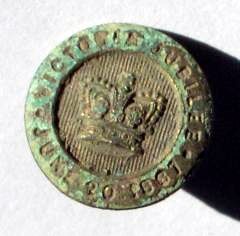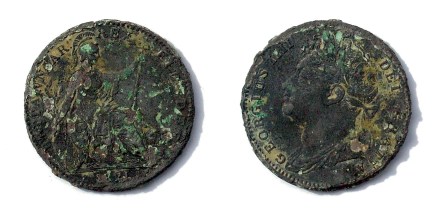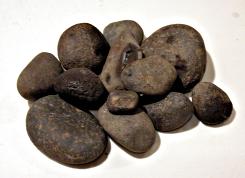

Digging paths and flowerbeds around the house has turned up lots of little artifacts. These brass buttons were found in the front and back gardens, respectively. The legend on the larger button says "Victoria Jubilee - June 20 1887." The smaller, rounded button is one of two identical buttons I've unearthed so far. It has a shield design emblazoned with what is probably arms associated with the parts of British Army at the time. The arms granted to the Board of His Majesty's Ordnance, 16th May 1823 are "azure, three field pieces in pale or, on a chief argent three pellets". These arms were already in use by the Army Council. Related arms belonging to the Royal Engineers and the Inspector General of Fortifications have been found on a similar larger brass button found close by at Fort Townshend.

This clay pipe bowl is typical of the dozens of pipe fragments found in the back garden. Whoever lived here in the late 1800s sure smoked a lot! In 2004 I found a stem for a pipe of about this age, marked "A GOGHILL" on one side, and "GLASGOW" on the other.

Some of the clay pipe fragments. Note the smaller, bowls with a foot and a greater angle to the stem. These are probably from before 1800. Likely they were smoked by soldiers on duty at the powder house.

This silver spoon has a hallmark, but so far it has proved illegible.

This 1821 British farthing is the oldest identifiable artifact I've found so far. It's quite corroded, but you can compare it to this other George IV farthing. I've also found a large coin that is probably an early Canadian penny, and a small coin that is simply too corroded to identify.

The rocks under the soil are mostly sharp bits of shale. These (and many other) beach rocks were probably brought here in the late 1800s, judging by the depth at which they were found. They are unremarkable and could be from anywhere. However, the people living here worked on the St. John's waterfront as wharfingers and tidewaiters when the city actually had beaches. I like to think that that's where these are from.

Two 1926 Nfld. license plates. The number is 2212. Found near pieces of an axle, an early spark plug, and many unidentifiable rusty lumps of metal.
Besides the items pictured here, I've found a flint stone a 69 caliber lead musket ball, and several clay marbles. Also, three buckets worth of glass and ceramic sherds and the leather heel of a child's shoe.